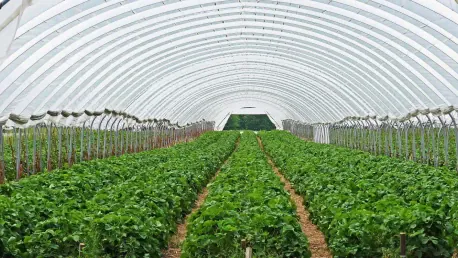The Canadian greenhouse sector is highly export-dependent, with 99.5% of its greenhouse vegetables being shipped to the United States in 2023. The imposition of U.S. tariffs on Canadian goods poses a significant threat to this industry. This article examines the potential ramifications of such tariffs and explores the ongoing efforts within the sector to mitigate these challenges.
Heavy Reliance on U.S. Exports
The Canadian greenhouse industry thrives on its exports to the United States, which is its principal market. In 2023, Canada exported $1.7 billion worth of greenhouse vegetables, with the majority going to the U.S. This dependence creates a vulnerability to trade disruptions, making the industry susceptible to financial losses if tariffs are imposed. Richard Lee, executive director of Ontario Greenhouse Vegetable Growers, highlighted the impact of a recent three-day imposition of tariffs, which cost Ontario’s greenhouse sector over $6 million. This incident exemplifies the immediate financial repercussions of such trade measures.
The sheer volume of produce grown by the Canadian greenhouse sector underscores the importance of the U.S. market. Ontario alone grows enough to feed the entirety of Canada ten times over, indicating a significant surplus that must find a market beyond domestic consumption. The heavy reliance on cross-border trade with the United States necessitates a stable and predictable trading environment, free from disruptive tariffs. The fragility introduced by such trade measures demands effective risk management strategies, underscoring the urgency to address this challenge.
Temporary Solutions and Uncertainty
U.S. President Donald Trump’s temporary suspension of tariffs on goods meeting rules-of-origin requirements under the Canada-U.S.-Mexico Agreement offers some respite. However, this solution introduces a layer of uncertainty and complexity for greenhouse producers, who must navigate these evolving trade policies to maintain stability. This temporary suspension, while providing immediate relief, does not assure long-term security for Canadian growers reliant on U.S. markets for their surplus production.
The landscape of international trade is dynamic, and short-term policy shifts can lead to enduring uncertainty. Greenhouse producers are left in a precarious position, needing to adapt continually to maintain their economic footing. The intricacies of trade agreements add to the complexity, requiring producers to remain vigilant and proactive. As the sector grapples with its immediate challenges, long-term strategic planning becomes essential for ensuring sustained success. The Canadian greenhouse industry’s ability to thrive amid such instability is a testament to its resilience and adaptability.
Limitations and Diversification Efforts
Canada’s greenhouse sector faces challenges in diversifying its crop variety due to climate and scale limitations. The primary focus remains on tomatoes, cucumbers, and peppers, which restrict flexibility in addressing trade disruptions. However, ongoing investments in research and new technologies aim to expand the range of crops that can be grown in greenhouses. Efforts to grow less traditional crops, such as tropical fruits and vegetables, are gaining momentum. The exploration of crops identified in the 2024 RBC report, including spinach, bananas, coffee, okra, and certain berries, showcases the sector’s attempts to mitigate risks and future-proof against trade vulnerabilities.
These diversification efforts are crucial in lessening reliance on a single market. By spreading risk across a broader range of produce, greenhouse operators can better withstand economic shocks. The introduction of new crop varieties requires not only technological innovation but also substantial investment in R&D. The shift toward expanding greenhouse capabilities showcases the sector’s commitment to long-term sustainability. Encouraging diversification is an essential step towards stabilizing the industry, enhancing its self-sufficiency, and strengthening Canada’s position within the global agricultural economy.
Infrastructure Challenges
Access to essential resources like energy and water compounds the greenhouse sector’s vulnerabilities. These infrastructure barriers can impact the ability to expand and adopt new technologies, hindering efforts to diversify and stabilize the industry in the face of trade uncertainties. The need for reliable, cost-effective energy and ample water supply is critical for greenhouse operations. Addressing these infrastructure challenges is paramount to supporting the sector’s growth and resilience.
The dependency on robust infrastructure aligns with the demands of high-tech agricultural practices. Overcoming these hurdles requires concerted efforts from both the industry and government to create a favorable operational environment. Investment in renewable energy sources and efficient water management systems can provide long-term solutions, ensuring the greenhouse industry’s sustainability. These infrastructure improvements are not just about immediate gains but are essential for the future stability and growth of the sector amid evolving trade dynamics.
The Rise of Vertical Farming
Vertical farming presents a unique solution to some of the challenges faced by traditional greenhouses. Lenny Louis, CEO of Vision Greens, notes the surge in demand for their lettuce and spring mix due to the tariffs. The controlled environment of vertical farms allows for a reliable local supply chain, offering an alternate source of produce during trade disruptions. Vertical farming’s potential to thrive in urban environments also promotes sustainability and reduces transportation costs, further enhancing its appeal.
Despite these advantages, vertical farms cannot entirely absorb the greenhouse sector’s surplus production. Dana McCauley, CEO of the Canadian Food Innovation Network, points out that while vertical farms offer an alternative, their products are typically more expensive. However, there is potential for more competitive pricing as these farms scale up. The vertical farming industry is poised for growth, driven by innovation and investment. As these operations expand and become more efficient, they may increasingly contribute to Canadian food security and offer a complementary solution to traditional greenhouse farming.
Future Strategies and Investment
The Canadian greenhouse sector heavily relies on exports, with 99.5% of its greenhouse vegetables being shipped to the United States in 2023. This dependency on the U.S. market means that any imposition of U.S. tariffs on Canadian goods would pose a significant threat to the industry and its economic stability. These tariffs could lead to increased costs, reduced competitiveness, and potential financial strain on Canadian greenhouse producers. This article delves into the potential consequences of such tariffs, emphasizing the economic challenges that may arise for Canadian greenhouse growers. Furthermore, it explores the proactive measures and strategies currently being adopted within the sector to counteract these potential obstacles. Initiatives such as diversifying export markets, improving production efficiencies, and lobbying for favorable trade agreements are crucial for mitigating the impact of tariffs. The sector’s resilience in facing these challenges will be key to sustaining its success and ensuring its future stability amidst evolving trade dynamics.









